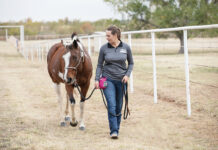In a world where lives are increasingly hectic and budgets are stretched razor-thin, many equestrians are making an unexpected discovery: Teamwork just might be the best way to care for a horse.

Shared Ownership
“Honestly, I don’t think I would have a horse again if I couldn’t share it with someone,” says Nancy Chin of Santa Cruz, Calif. She has shared Flash, a 15-year-old Morgan gelding, with Barbara Arroyo for the past 10 years.
The pair bought Flash together spontaneously at a local breeding-barn liquidation sale and have shared equally in all of his costs and responsibilities since then. Individually, each rider was overwhelmed by the prospect of buying a horse, but together, it seemed manageable.
In hindsight, they chuckle about the absence of formal planning but wonder if their 10 harmonious years without a written contract might be an indicator of how well these relationships can work with the right people involved.
The share has worked so well that Chin and Arroyo now question the merits of sole ownership, particularly in terms of the horse’s well-being. In places like coastal California where they live, turnout is almost non-existent due to the high price of land, so sharing a horse helps ensure it gets enough exercise.
“This is not just about the cost,” says Chin. “If you work full-time, you physically cannot get your horse out every day. And they need to get out and move.”
Having multiple owners covers all the bases for the horse, while simultaneously meeting each rider’s needs. In the case of Chin and Arroyo, the women’s schedules vary enough that they seldom find themselves in conflict for riding time.
Leasing
Types and terms of sharing and lease arrangements vary as much as the horses they serve. For Jana Marquardt of the San Francisco Bay area, sharing her gelding with lessees offered her a chance to pass along her knowledge of horsemanship and dressage.
Marquardt honed her skills on borrowed horses as a working student throughout high school before getting her own horse. When she added graduate school to her schedule, she knew the most beneficial decision for her—and her horse Binki—was to team up with someone. She asked for referrals from her network of trainers and friends and entered a half-lease with a young woman learning dressage.
“I had limited time, but I wanted to keep [Binki] moving and healthy,” says Marquardt. She regularly coaches her lessee while continuing to ride Binki three times a week herself. She believes this sharing of expertise adds value and focus to lease arrangements. Binki’s current lessee, 15-year-old Maya Desai, agrees.
“It’s a great way to learn from another person, especially when that person is more accomplished,” says Desai. Her lease terms include not only riding the 20-year-old gelding, but also providing an equal share of his maintenance costs, including supplements, blanketing and care.
More important for Marquardt than a lessee’s riding expertise or preferred discipline is how much that person can contribute to the horse overall. “The question I ask is, ‘Does the rider maintain or enhance the horse’s mental and physical well-being?’
“I’m pretty picky. I’m very upfront with my expectations. I’m looking for that thoughtful, caring person of any age, and I think you can get a good read on someone by watching them interact with your horse for a while.”
Long-Distance Collaboration
Marsha Heiden of Garrettsville, Ohio, agrees that leases or co-ownerships can produce win-win benefits for riders and owners along with optimal well-being for the horse.
This led Heiden, a former dressage instructor at Lake Erie College, to involve co-owners in two of her young Andalusians, which meant sending the horses out of state to live and train. This arrangement is working for everyone involved.
Heiden’s experience illustrates the possibility that achieving a horse’s full potential might require teamwork. “I buy, breed and start young horses, but I can’t ride all of them or attend to them the way a single, fully engaged co-owner can do,” she says.
“My goal was to get my finest horses into the hands of great riders with great trainers that would allow the horses to get the opportunities that I alone can’t provide.” In cases like these, Heiden’s partners are able to train on horses they might not otherwise get to ride. Meanwhile, Heiden can rest assured her horses are getting the care and consistency they need.
Since last year, Stephanie Boyles of Boulder, Colo., has co-owned Kyra, a 5-year-old Andalusian mare, with Heiden. The collaboration has fulfilled Boyles’ interests in learning how to develop a horse’s potential, and she values the knowledge that Heiden brings to the relationship.
“To have a partner to think through the stages of training is really valuable to me because I like the conversation,” says Boyles.
Put it in Writing
To ensure their relationship remains smooth, Heiden and Boyles keep a clearly written agreement, especially in regards to who pays for what. Since the horse lives in her custody, Boyles pays for all current training and expenses in addition to any major medical costs. Heiden reserves the right to fly out and ride Kyra on occasion, and would receive half of the sale price if both parties agree to sell her.
A strong written agreement can prevent miscommunication, financial issues or clashes when planning for the future. Perhaps more importantly, says Boyles, is that it makes co-owners think about all the possible situations that might arise during the commitment.
The wording and formality of these contracts varies greatly. Sample lease forms can be found online; many riders draw up their own documents. These are helpful, even when there is no monetary obligation on a lessee’s part, says Marquardt. “Make sure everything is spelled out in a lease agreement, even if it’s a work exchange,” she advises.
This includes the steps necessary to terminate the commitment, stipulations of use (number of days per week, activity types, limitations of use) and other considerations. Both parties need to clarify their expectations for all areas of a horse’s use and care. This helps dispel the litigious anxiety that prevents more people from sharing horses, in Marquardt’s opinion.
Peace of Mind
Over the years of leasing her older school horses to students, Tunbridge, Vt., dressage trainer Lori Berger recognizes the value of an agreement written by an attorney. While she believes the positive aspects of lease arrangements outweigh any negatives, a sound contract can offer peace of mind, especially when the lessee and the owner aren’t at the same barn. She currently has two horses leased out, one on her farm and one elsewhere in Vermont.
“Leasing is a great option when all parties are very clear on what everyone’s responsibilities are, especially financially,” says Berger. She cites the example of colic surgery: state who should make the decision to do it, and who should pay for it.
Post-Competition Life
“I’ve found that leasing out my horses when they’re no longer able to perform the jobs I do with them is a way for me to ensure that they’re in good situations as they age,” says Berger.
Lease agreements made by trainers can allow students access to schoolmasters. In exchange, leasing ensures Berger’s horses’ maintenance expenses are taken care of and they continue to get attention and exercise after they retire from top-level competition.
“My student has the opportunity to ride a horse with more training than she could have afforded to buy, and I am thrilled at the amount of attention my mare receives,” says Berger.
Overall, horse sharing is a winning situation for all involved when everyone understands the terms. The financial benefit to both individuals is clear, but the party with the most positive outcome remains the horse.
This article originally appeared in the April 2016 issue of Horse Illustrated magazine. Click here to subscribe!





